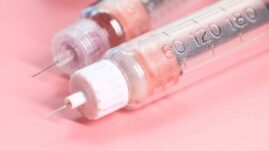Living with diabetes often means generating “sharps” waste, like needles, syringes, and continuous glucose monitor (CGM) applicators.
This article will explain what qualifies as sharps, how to dispose of them safely, and where to find state-specific disposal rules or local drop-off options — some cities even offer pickup services.

Key Points:
- Sharps include needles, syringes, lancets, infusion sets, and CGM applicators used by people with diabetes.
- Always store used sharps in a strong plastic container. Do not throw them in the trash or recycle bin.
- Many U.S. states allow sealed sharps containers in household trash, but local rules may vary.
- Use sites like SafeNeedleDisposal.org to locate nearby drop-off
What are “sharps”?
“Sharps” refers to medical devices with sharp points or edges that can puncture or cut skin, including needles, syringes, infusion sets, lancets, CGM applicators, and auto-injectors.
Improper disposal of sharps can lead to accidental needle sticks and the spread of infections, making safe disposal critical for protecting both individuals and the community.
With millions of people using sharps outside of healthcare settings, proper disposal is essential to prevent injury and maintain safety.
How to store used sharps at home
Sharps should never be thrown in the trash or recycling, as improper disposal can cause injury.
Whether you’re disposing of insulin needles or other diabetes supplies, it’s recommended to store them in a strong, puncture-resistant container, like an official sharps container, which can be bought at pharmacies or online.
If you prefer not to buy one, a thick plastic detergent or bleach bottle will work, but avoid thin plastic containers like water bottles, as sharps can puncture them.
Additionally, some pharmacies or healthcare providers offer free sharps containers, so it’s worth asking if you qualify.

For unused, unopened sharps in original packaging, consider donating them to organizations like World Medical Relief (1-313-866-5333) for use.
When should sharps containers be emptied or thrown out?
Avoid overfilling your sharps container. Once it’s about three-quarters full, seal it and start a new one. Many sharps containers come with indicators to let you know when it’s time to dispose of them.
How to dispose of a sharps container
In most U.S. states, you can dispose of sealed sharps containers in the household trash (but never in the recycling bin), though it’s illegal to discard loose needles or syringes.
However, states like California and Massachusetts, as well as certain areas, have stricter rules.
Always check your local regulations for approved drop-off sites or available collection services.
You can watch this video to learn more about sharps and how to dispose of them.
Did you find this article helpful? Click Yes or No below to let us know!




bobbie
there’s nothing within 10 miles of where I live
Christel Oerum
That’s disappointing. You could try your local hospital or firestation
Danette warner
I live in Minneapolis and our recycling takes sealed and marked sharps (laundry soap) containers. Makes it easy for us!
Christel Oerum
That’s amazing! Thank you for mentioning that
Just Julie
Check with your local Fire Department, ours will take a full sharps container and give you a new one for free.
Jodi
My zip code has no place to take the full box. I don’t drive and I’m in an apartment. What do I do with my red container?
Thank you,
Jodi
Christel Oerum
Ah, that’s too bad that the SafeNeedleDisposal.org site couldn’t help with that. You might have to do some googling/calling around your local area. Your doctor’s office or hospital may collect their patients’ sharps (but check first) Other sites include pharmacies and “household hazardous waste (HHW) facilities”
Stgeorge
Thank you for sharing this information, I think this is an overlooked problem, especially if you have children. Even the trash men who risk being poked with needles. Taking the necessary precautions to properly dispose of these needles.
Christel Oerum
Thank you, yes I agree. When researching this article I was even surprised of what can and cannot go in the trash.